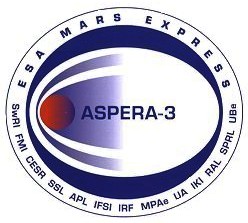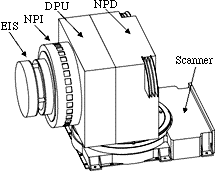
|
ASPERA-3: Analyzer of Space Plasmas and EneRgetic Atoms
|
 |

|
ASPERA-3: Analyzer of Space Plasmas and EneRgetic Atoms
|
 |
 ASPERA-3 is an advanced and compact ion, electron and neutral particle detector package developed for the MarsExpress mission to investigate the plasma and neutral particle environment near Mars. ASPERA-3 will perform the first ever Energetic Neutral Atom (ENA) measurements at another planet in the low energy range (100 eV - 10 keV).
ASPERA-3 is an advanced and compact ion, electron and neutral particle detector package developed for the MarsExpress mission to investigate the plasma and neutral particle environment near Mars. ASPERA-3 will perform the first ever Energetic Neutral Atom (ENA) measurements at another planet in the low energy range (100 eV - 10 keV).
| Science objectives | |||||||||
| Instrument description | |||||||||
MPS contribution
|
|||||||||
| Related links | |||||||||
| ASPERA-3 publications by MPS members |
The general scientific objective of ASPERA-3 is to study the solar wind - atmosphere interaction and to characterize the plasma and neutral gas environment in the near-Mars space through ![]() Energetic Neutral Atom (ENA) Imaging and in-situ plasma measurements. ENA imaging is a novel technique to visualize and monitor processes in dilute gases. ENAs are produced via charge exchange processes between singly-charged ions and neutral gases of the exosphere / upper atmosphere. Due to their neutrality, ENAs are decoupled from the electromagnetic fields and propagate on straight paths like photons. Directional detection of the ENAs therefore yields a global image of the interaction region.
Energetic Neutral Atom (ENA) Imaging and in-situ plasma measurements. ENA imaging is a novel technique to visualize and monitor processes in dilute gases. ENAs are produced via charge exchange processes between singly-charged ions and neutral gases of the exosphere / upper atmosphere. Due to their neutrality, ENAs are decoupled from the electromagnetic fields and propagate on straight paths like photons. Directional detection of the ENAs therefore yields a global image of the interaction region.
The studies to be performed address the fundamental question: How strongly do the interplanetary plasma and electromagnetic fields affect the Martian atmosphere? This question is directly related to the problem of Martian dehydration. Where is the water? Is it lost or frozen? If it is the former, what could produce such an effective escape mechanism? If it is the latter, where is the tremendous amount of water stored? Since liquid water is the fundamental requirement for life, a clear understanding of the fate of the Martian water is a crucial issue in resolving the problem whether or not life existed on Mars in the past. No instruments with similar scientific objectives and capabilities have been or are planned to be flown to Mars.
ASPERA-3 comprises four sensors:

To increase angular coverage NPI, NPD, and EIS are mounted on a scanning platform.
| NPI | NPD | IMA | EIS | |
|---|---|---|---|---|
| Particles | ENA | ENA | ions | electrons |
| Energy, keV | 0.1 - 60 | 0.1 - 10 | 0.01 - 40 | 0.001 - 20 |
| Energy res. dE/E | - | 80% | 10% | 7% |
| Mass res. | - | H, O | M/dM = 5 | - |
| FoV | 9° x 344° | 9° x 180° | 4.6° x 360° | 10° x 360° |
| Angular Res. (FWHM) | 4.6° x 11.5° | 5° x 30° | 5° x 22.5° | 5° x 22.5° |
| G-Factor/pixel, cm2 sr | 2.5 x 10-3 | 6.2 x 10-3 | 3.5 x 10-4 | 3 x 10-4 |
| Efficiency, % | 1 | 1 - 25 | n/a | n/a |
| Time res. for full 3D, s | 32 | 32 | 32 | 32 |
ASPERA-3 is realized by a large international consortium of more than 10 European and US institutes. The ![]() team is led by R. Lundin (Swedish Institute of Space Physics, Kiruna). The MPS, in cooperation with IDA (University Braunschweig) and IFSI, Rom, is supplying the electronics of the NPD sensor and will take part in the scientific data analysis.
team is led by R. Lundin (Swedish Institute of Space Physics, Kiruna). The MPS, in cooperation with IDA (University Braunschweig) and IFSI, Rom, is supplying the electronics of the NPD sensor and will take part in the scientific data analysis.
|
Swedish Institute of Space Physics |
|
|
Aspera-3 site at IRF |
| © 2006, Max Planck Institute for Solar System Research, Lindau |
Woch 26-09-2005 |